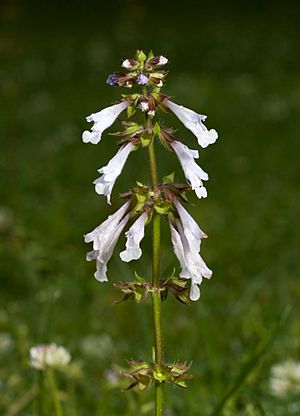Lyre-leaf sage facts for kids
Quick facts for kids Lyre-leaf sage |
|
|---|---|
 |
|
| Scientific classification |
Salvia lyrata, also known as lyre-leaf sage or wild sage, is a cool plant that grows year after year. It belongs to the Lamiaceae family, which includes many herbs like mint. You can find this plant growing naturally across the United States, from states like Connecticut and Missouri in the north, all the way down to Florida and Texas in the south. A famous scientist named Carl Linnaeus first described and named this plant way back in 1753.
Contents
Meet the Lyre-Leaf Sage!
What Does It Look Like?
The lyre-leaf sage starts with a flat cluster of leaves close to the ground, called a basal rosette. These leaves can grow up to about 20 centimeters (8 inches) long. They get wider towards the end and have wavy edges. Often, they look a bit like a lyre, which is an old musical instrument. Sometimes, the main vein in the leaves can even be a cool dark purple color!
From the center of these leaves, a square-shaped stem grows straight up. This stem can reach about 60 centimeters (2 feet) tall and has soft hairs on it. Along the stem, you'll see pretty lavender to blue flowers. Each flower has two lips, like a tiny mouth. The plant blooms most in spring, from April to June, but you might see a few flowers at other times of the year too.
Where Does It Grow?
Lyre-leaf sage loves places where it can get lots of sunshine or a mix of sun and light shade. You can often spot it growing along roadsides, in open fields, and in forests that aren't too dense. It's a tough plant that can adapt to different spots.
Old Beliefs About the Plant
One of the old common names for this plant is "Cancerweed." This name came from a belief long ago that the leaves could be used on the skin to help with cancer. However, this was just an old folk belief and is not a medical treatment used today.
Growing Lyre-Leaf Sage
In Your Garden
People sometimes plant lyre-leaf sage in their gardens because its leaves and flowers are quite attractive. It's known for being easy to grow. However, it can also spread its seeds very easily. This means it might pop up in many places in your lawn or garden, sometimes becoming a bit of a "weed" if you're not careful!
Special Varieties
Plant growers have even created special types of lyre-leaf sage with purple leaves. These are called 'cultivars'. Two popular ones are 'Burgundy Bliss' and 'Purple Knockout'. Their leaves are an even deeper, richer burgundy color than the regular plant.
Traditional Uses
Long ago, Native Americans used parts of the lyre-leaf sage for different purposes. They would use the root to make a kind of salve, which is a healing ointment, for sores on the skin. They also made a tea from the whole plant to help with colds and coughs.
Gallery



